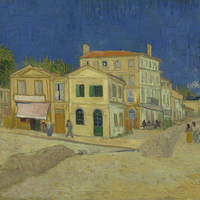Goldmember would totally love this painting by Giotto.
I mean, really. Just look at all that gooold! The use of gold leaf, especially to create an all-gold background, was extremely popular in medieval painting. This technique eventually faded away when Italian Renaissance artists began to favor more natural-looking settings over the blinding shine of gold. Centuries later, artists rediscovered the ethereal effects of gold leaf. The gold backgrounds of the paintings in Titus Kaphar’s The Jerome Project echo the majesty of these early Italian works and once again use the coveted material to communicate that which is important and holy.
Going for the tried and true subject matter of the life of Christ, Giotto originally painted seven scenes on a single, horizontal wooden panel. The scenes have since been divided up and sold, which was usually a tactic to make the most money possible from a single work of art. To see all seven panels, you’ll have to do some traveling. Besides this one at Isabella Stewart Gardner Museum, the other panels are at The Metropolitan Museum of Art in New York, the National Gallery London, and the Alte Pinakothek in Munich. Curiously, there are some pretty notable scenes missing from this cycle. The Annunciation and the Resurrection, some of the most famous scenes from the life of Christ, are nowhere to be found. Instead, Giotto opted for some lesser-known biblical stories, including this painting’s representation of Simeon and Anna recognizing this otherwise normal baby as the Christ Child and savior of mankind. Good eye.
Although it was created in the early fourteenth century, this painting was first documented when the Polish Prince Stanislas Poniatowski bought it in 1822. He purchased four panels in total, including the ones that are now at the Met and the National Gallery. Almost a century later, Isabella Stewart Gardner purchased her panel from Bernard Berenson, an influential Italian Renaissance scholar who often acted as a consultant to prominent American art collectors and museums in the early twentieth century.
Berenson worked for four years to acquire this extraordinary example of Giotto’s work for Gardner. Gardner adored Giotto and badly wanted this piece for her collection, even if she did have some initial hesitation coming up with the $1,500 to buy it. She ultimately chose the Giotto over a Rembrandt that Berenson was also trying to sell to her. Luckily, this was an easy choice for Gardner; while she adored Giotto, she only just liked Rembrandt. This purchase was a good opportunity to bulk up her collection of Italian masters, which also includes a work by Andrea Mantegna that Berenson openly lusted after. Don’t you just love first world problems?

















Amazing work